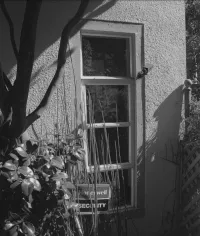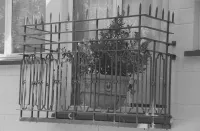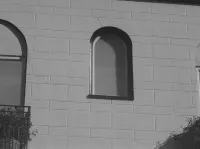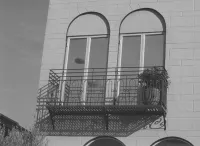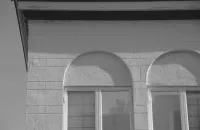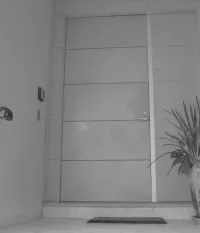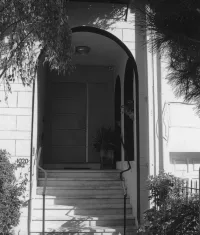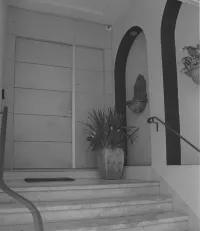Share what you know,
and discover more.
Share what you know,
and discover more.
Dec 22, 2011
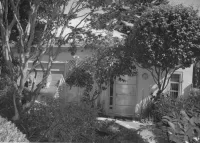
-

- Charmaine Bantugan
Sinton House - National Register of Historic Places
Statement of Significance (Provide a summary paragraph that includes level of significance and applicable criteria.) The Sinton house is significant under National Register Criterion B at the local level of significance for its association with the artist Eleanor (Nell) W. Sinton as her residence for 44 years and the property in which she created some of her best-known works, Mrs. Sinton is recognized as one of California’s earliest prominent female abstract expressionists and found national fame over the years for both her paintings and her later assemblages and collages. Criteria Consideration G: Properties That Have Achieved Significance Within the Past Fifty Years applies because Nell Sinton’s significance as an artist continued to develop beyond 1961 into the 1970s. The culmination of her career occurred in 1981 with a 30-year retrospective exhibition. She was also a major force in the promulgation and teaching of the arts in the Bay Area. The Sinton House was designed and built in 1927 and remodeled in 1955. It is significant under National Register Criterion C for its association with two noted architects: the original designer John (Giovanni) A. Porporato (1877-1965), a lifelong resident of San Francisco and a premier Italian-American designer; and William Wilson Wurster (1895-1973), an architect strongly associated with the regional contemporary styles of the Bay Area, who was responsible for the major interior alterations to the house in 1955 under Mrs., Sinton’s direction. Porporato’s distinctive architectural stylings engaged a classical vocabulary borrowing on the traditions of European architecture, particularly Italian Renaissance Revival. Each building type he produced notably displayed a highly resolved period revival rationale, Wurster’s milieu, on the other hand, was to consider a holistic approach to the total built environment. The constraints of an interior rehabilitation of an Italian Renaissance Revival residence would neither preclude his architectural sensibilities nor confound them. His tempered methodology regarding the Sinton House rehabilitation conceded that the primary interior public spaces would be rearranged in order to maximize view, light, and circulation yet not betray the basic character-defining features of Porporato’s work on the exterior. The totality of Wurster’s approach to a then-modern rehabilitation of a period residence served not only as a precursor to his later essays in modernism, but was a model for blending the ideals of California living in the 1950s with those of an earlier era. Narrative Statement of Significance (Provide at least one paragraph for each area of significance.) Criterion B: In 1926, Anthony N. Lanza (1896-1986), a native of Italy, purchased the lot on Russian Hill from John A. Scannavino and commissioned San Francisco architect John A. Porporato to design a residence in an Italian Renaissance style. C. Lindberg was the builder. Lanza was in the real estate business. Living with him were his wife Tonina, his daughter Rose, and his son Francesco (Frank) Lanza, a fruit broker, and Frank’s wife Catherine. The Lanzas later established the Lanza Wine Company on Washington Street in San Francisco’s North Beach neighborhood, a center of Italian-American life at the time. The Lanza family occupied their Francisco Street home until 1943. The next owner of the house was Marjorie Finocchio who shared it with her husband Joseph Finocchio. Mr. Finocchio (1897-1986), born in Italy, had a somewhat notorious reputation as owner of a female-impersonator nightclub located on Broadway. Between its founding in 1936 and its closing in 1999, Finocchio’s became a North Beach institution, a favorite among tourists, attracting over 300,000 customers a year. Between 1950 and 1954, the house was owned by Herbert W. and Ethel M. Beck. In 1954 Stanley Henry Sinton, Jr., and his wife Eleanor (Nell) Walter Sinton became the owners of the house. Eleanor Sinton, usually referred to by the nickname “Nell,” was a member of one of San Francisco’s prominent Jewish-American families who had been residents of the city since 1851. Born Eleanor Walter on June 4, 1910, she was the daughter of John I. Walter, a businessman and art patron, and Florence (Schwartz) Walter, who would become a bookbinder of international renown.'' Neither parent considered art (or for that matter any career) appropriate for a young lady of that era—marriage, a family, some civic involvement, and perhaps a hobby was all she should aspire to. Nell, who early on thought of herself as a rebel, received her earliest education at the Katherine D. Burke School, graduating in 1918. In 1922 she began cultivating her interest in art by attending Saturday morning classes at the San Francisco Art Institute (then called the California School of Fine Arts) which met at the Mark Hopkins Hotel. By 1925, she was attending full-time, studying under such well-known artists as Maurice Sterne, Spencer Mackay, Lucien Labaudt, and Ralph Stackpole. Nell married Stanley Sinton Jr. in 1930. They would have two daughters and one son. Stanley Sinton, Jr. (1908-1982), a native of Boston, was the son of a stockbroker who had been born in San Francisco. A graduate of Yale, Sinton, Jr. was chairman of the board of the D. N. & E. Walter Company, a wholesale fabric and upholstery firm owned by his wife’s family. He also served as president of the San Francisco Planning and Urban Research Association (SPUR). He was remembered as a philanthropist and as a visionary in the movement for orderly development of the city. In the 1940s, Mrs. Sinton returned to the San Francisco Art Institute for further instruction with Maurice Sterne. By then, it had become the flourishing center of the local abstract expressionist movement. The era from 1949 to 1954, sometimes referred to as “the brilliant period,” coincided with Mrs. Sinton’s first recognized artistic creations. The first exhibits of her work occurred in 1947 at the Raymond & Raymond Gallery in San Francisco and at the California Palace of the Legion of Honor. These were followed in the later 1940s and 1950s by exhibits of contemporary art at the Santa Barbara Museum of Art and the Bolles Gallery of San Francisco and New York City in which she was one of just two women participants. The Bolles Gallery purchased some of Mrs. Sinton’s pieces for its permanent collection. Other exhibits were mounted at the San Francisco Museum of Modern Art, the Stanford Research Institute, the Oakland Art Museum, the Vancouver Museum, and the Metropolitan Museum of Art in New York which gave her an award in 1956. In later years her work was seen at the Smithsonian Institution, the Chicago Art Institute, the National Museum of Women’s Arts in Washington, DC, the Denver Museum, the American Academy of Arts in New York, the Los Angeles County Art Museum, the Claremont Colleges, the University of California at San Francisco, Louisiana State University, and the University of Illinois. Several of these exhibits focused on the Bay Area’s emerging abstract expressionist movement and included not only works by Nell Sinton but by such artists as Richard Diebenkorn and Ralph DuCasse. It is no coincidence that Mrs. Sinton’s impressionist artwork flourished in the 1950s. She had begun to embrace an independent spirit not only in her life but also in the type of dwelling that she preferred to live in. In 1952, family accounts indicate that Mrs. Sinton had been feeling “disquieted." The early 1950s were a time of change as Mrs. Sinton found herself moving from the role of mother/socialite to “empty nester.” Her rather cold, formidable Tudor Revival residence at 2520 Divisadero Street with no studio space was viewed as being “restrictive and archaic.” She desired something lighter and more modern with expansive views that would surround her with a more positive environment. When the Sinton’s sold their Pacific Heights residence they left the august neighborhood of Pacific Heights for the somewhat more Bohemian flavored Russian Hill. In 1959 Mrs. Sinton was acknowledged as one of the Ten Most Distinguished Bay Area Women and her work had been reviewed in such acclaimed publications as Art Forum. in addition to producing her art, Mrs. Sinton served from 1958 to 1963 on the San Francisco Art Commission (from which she was to receive an Award of Honor in 1984). Beginning in 1966 she was a member of the Board of Trustees of the San Francisco Art Institute, a position she held until her death. As one of the few practicing artists on the Board, she appears to have been particularly concerned with the welfare of the Institute’s students. She not only contributed generously to the Institute, but, in fact, purchased the works of many of the students, believing in giving them a hand-up rather than charity. She also provided them space at her summer home at Lake Tahoe, in exchange for their helping out with such chores as housework and childcare for her grandchildren. * Mrs. Sinton went on to become San Francisco’s leading female art patron, as well as an artist in her own right and mentor to several promising artists including Carlos Villa (1936 -). In 1969, Mr. and Mrs. Sinton divorced. By all accounts, Mr. Sinton had always been supportive of his wife’s work and “loved what she did.” Mr. Sinton later re-married, Mrs. Sinton did not, devoting herself more fully to her art, and teaching at various universities throughout the country as an artist-in-residence. It was a double pleasure for her to leave home and to teach at the university level which, due to family and societal pressures and responsibilities, she had never attended as a student. Mrs. Sinton had two productive periods—abstract expressionist paintings in the 1950s and 1960s and constructionist feminist works and parodies beginning in the 1970s.’" Mrs. Sinton began her career in the 1940s producing figurative family scenes and representational cityscapes but, by the 1950s, she had moved to abstract oils and watercolors. Using traditional pigments at first, by 1964 her preferred painting material was acrylic on canvas. She was considered to be a beautiful colorist. Some of her paintings included collages. Such works as “Vertical Landscape" (1958), Orange Landscape” (1959), and “Mount Ida” (1964) incorporated bold colors and shifting shapes, while others, like “Greenhouse” (1961) were boldly defiant in their abstraction—a rare feature in women's art at the time. In fact, works by women were largely ignored by the male-dominated art world of the 1960s, a fact brought to light by protesting groups of women, such as the “Guerilla Girls” who staged protests at art shows clad in gorilla masks. Though Mrs. Sinton helped finance some of these protest groups, the participants tended to be a generation younger.’"' Mrs. Sinton’s female contemporaries, including Ruth Armer and Adaline Kent, were inclined to be much more conservative, their works less vibrant and issue oriented than those of Nell Sinton. Mrs. Sinton was known for taking risks. Her work illustrated the powerful, dynamic, and vibrant qualities of her nature, as well as providing social commentary - very different from her colleagues. For example, her works documenting the social development of the American woman would include nudes of robust, overweight females meant as a parody of the “ideal” femininity embraced by the culture of the 1950s and ‘60s. Later, collages, scrolls, boxes, and other constructions depicting varied subject matter, from the traditional figurative to almost surreal, dominated Mrs. Sinton's work. Blending drawing, writing, and painting, they tended to be very expressive of her life experiences, not only her feelings of being ignored as a woman artist, but also the constant tension she felt between her wealthy art-patron family background and her desire to be recognized as an artist in her own right. Her scrolls could be as long as thirty feet, often telling longitudinal stories, such as “Under the Table at the Donner Party: A Dining Room Frieze” and “A Social Development of an American Female,” begun in 1974. In the 1970s Mrs. Sinton became known for her assemblages and boxes—containers filled with unusual ephemera that were positioned with “delicate harmony” and appealed to the “cross-harmony of different senses.” Her "Sterilizer” was a wood-and-glass orange cabinet containing cotton and other materials. When opened it exuded “the forgotten odor of an old-fashioned doctor’s office.” Sight and sound combined eerily in “Pyramid Lake”—a boxed rock that looked like a petrified brain accompanied by a music box playing “Swan Lake.” “It spoke of the closeness between high civilization and basic mythical impulse.” According to Dr. Phil Linhares, Chief Curator of Art, The Oakland Museum of California, Nell Sinton’s later works “reflected current thinking on women’s liberation” and equaled or exceeded her earlier pieces in importance and quality. In his view, Mrs. Sinton was never an “old” person and always lived in the here and now. This made her a “very adaptable artist who did not settle on a particular image to define her work. Grace Morley, art critic and the first director (1934-1958) of the Museum of Modern Art in San Francisco, said of Sinton that "among artists of her own locality she is well-known and she has a sure place nationally. Her works speak directly to the sensitive viewer on their own terms. She is deeply receptive to the possibilities of her medium, for her art, whatever its style, has been marked by a sensitivity in which external stimulus for the work and the means of its execution have both played their part, along with her intimate feelings. She has been an innovator in her own development as an artist, very aware of the evolution of today’s art as represented in the work of her contemporaries. She has valued her own development, and is sympathetic to the movements of her time. It is the breadth of her personal curiosity and excitement that one feels strongly in reviewing Nell Sinton’s work through the years.” Many of Mrs. Sinton’s later works are still owned by the family, but her earlier paintings occasionally come on the market. San Francisco was not a big collecting town in the early days of abstract expressionism and women’s art was not commercially viable. However, Mrs. Sinton’s work has experienced an increasing value and popularity as women’s roles in the early abstract expressionist movement in San Francisco, in which she played an integral part, have become more recognized and appreciated in recent years. In the mid-1970s, Mrs. Sinton taught at the San Francisco Student League and at Oakland’s Institute for Creative and Artistic Development and was an instructor in painting and drawing at the College of Marin. She also served as a guest artist and lecturer at the University of California at its Berkeley and Irvine campuses, the University of Hawaii, Mount Holyoke College, the University of Massachusetts, and Smith College. She was an art juror and a published art critic. Other institutions presenting her with awards included the De Young Museum (1956) and the Oakland Museum (1958 and 1961). Mrs. Sinton’s works are found in the permanent collections of the Quay Gallery, American Telephone & Telegraph (AT&T), the University of California, Chase Manhattan Bank, Lytton Savings and Loan Association, and Mills College. In 1981, Mills College held a thirty-year retrospective of her work. Her own collections (which she began at the age of 18 and which filled her Francisco Street house) included Pre-Columbian pottery and contemporary American and European paintings and sculptures. She was an associate of Richard Diebenkorn and owned several of his works. They sometimes exchanged paintings. Nell Sinton actively stopped producing art in 1995 according to family accounts. Her studio was used solely as her space to produce art. By the early 1990s she began to experience advanced dementia (Alzheimer’s Disease) and stopped producing art methodically. Her last work, completed in 1995, a piece in which Sinton had lost the ability to draw perspective, is untitled and in family ownership. Nell Sinton died on October 23, 1997 at the age of 87, having lived her entire life in San Francisco. An oral history, recorded in 1992, is in the collection of the Bancroft Library at the University of California, Berkeley. Mrs. Sinton’s papers and a shorter 1974 oral history are housed at the Smithsonian Institution’s Archives of American Art. The Sinton house has had three owners since the Sinton family sold it in 1998; the Poundstone Trust (Brad and Kristina Rotter) from 1998 to 2000; Todd and Diane A. Blake from 2000 to 2003; and the current owner Sonja Moelleken O’Brien since 2003. In 1998 the Rotters made the most recent changes to the exterior of the front facade: the addition of a subterranean garage and the replacement of the original front door. Other post-Sinton alterations included the addition of rooms and glass porches on the rear facade and the widening of window openings in the artist’s studio/guest quarters.
Sinton House - National Register of Historic Places
Statement of Significance (Provide a summary paragraph that includes level of significance and applicable criteria.) The Sinton house is significant under National Register Criterion B at the local level of significance for its association with the artist Eleanor (Nell) W. Sinton as her residence for 44 years and the property in which she created some of her best-known works, Mrs. Sinton is recognized as one of California’s earliest prominent female abstract expressionists and found national fame over the years for both her paintings and her later assemblages and collages. Criteria Consideration G: Properties That Have Achieved Significance Within the Past Fifty Years applies because Nell Sinton’s significance as an artist continued to develop beyond 1961 into the 1970s. The culmination of her career occurred in 1981 with a 30-year retrospective exhibition. She was also a major force in the promulgation and teaching of the arts in the Bay Area. The Sinton House was designed and built in 1927 and remodeled in 1955. It is significant under National Register Criterion C for its association with two noted architects: the original designer John (Giovanni) A. Porporato (1877-1965), a lifelong resident of San Francisco and a premier Italian-American designer; and William Wilson Wurster (1895-1973), an architect strongly associated with the regional contemporary styles of the Bay Area, who was responsible for the major interior alterations to the house in 1955 under Mrs., Sinton’s direction. Porporato’s distinctive architectural stylings engaged a classical vocabulary borrowing on the traditions of European architecture, particularly Italian Renaissance Revival. Each building type he produced notably displayed a highly resolved period revival rationale, Wurster’s milieu, on the other hand, was to consider a holistic approach to the total built environment. The constraints of an interior rehabilitation of an Italian Renaissance Revival residence would neither preclude his architectural sensibilities nor confound them. His tempered methodology regarding the Sinton House rehabilitation conceded that the primary interior public spaces would be rearranged in order to maximize view, light, and circulation yet not betray the basic character-defining features of Porporato’s work on the exterior. The totality of Wurster’s approach to a then-modern rehabilitation of a period residence served not only as a precursor to his later essays in modernism, but was a model for blending the ideals of California living in the 1950s with those of an earlier era. Narrative Statement of Significance (Provide at least one paragraph for each area of significance.) Criterion B: In 1926, Anthony N. Lanza (1896-1986), a native of Italy, purchased the lot on Russian Hill from John A. Scannavino and commissioned San Francisco architect John A. Porporato to design a residence in an Italian Renaissance style. C. Lindberg was the builder. Lanza was in the real estate business. Living with him were his wife Tonina, his daughter Rose, and his son Francesco (Frank) Lanza, a fruit broker, and Frank’s wife Catherine. The Lanzas later established the Lanza Wine Company on Washington Street in San Francisco’s North Beach neighborhood, a center of Italian-American life at the time. The Lanza family occupied their Francisco Street home until 1943. The next owner of the house was Marjorie Finocchio who shared it with her husband Joseph Finocchio. Mr. Finocchio (1897-1986), born in Italy, had a somewhat notorious reputation as owner of a female-impersonator nightclub located on Broadway. Between its founding in 1936 and its closing in 1999, Finocchio’s became a North Beach institution, a favorite among tourists, attracting over 300,000 customers a year. Between 1950 and 1954, the house was owned by Herbert W. and Ethel M. Beck. In 1954 Stanley Henry Sinton, Jr., and his wife Eleanor (Nell) Walter Sinton became the owners of the house. Eleanor Sinton, usually referred to by the nickname “Nell,” was a member of one of San Francisco’s prominent Jewish-American families who had been residents of the city since 1851. Born Eleanor Walter on June 4, 1910, she was the daughter of John I. Walter, a businessman and art patron, and Florence (Schwartz) Walter, who would become a bookbinder of international renown.'' Neither parent considered art (or for that matter any career) appropriate for a young lady of that era—marriage, a family, some civic involvement, and perhaps a hobby was all she should aspire to. Nell, who early on thought of herself as a rebel, received her earliest education at the Katherine D. Burke School, graduating in 1918. In 1922 she began cultivating her interest in art by attending Saturday morning classes at the San Francisco Art Institute (then called the California School of Fine Arts) which met at the Mark Hopkins Hotel. By 1925, she was attending full-time, studying under such well-known artists as Maurice Sterne, Spencer Mackay, Lucien Labaudt, and Ralph Stackpole. Nell married Stanley Sinton Jr. in 1930. They would have two daughters and one son. Stanley Sinton, Jr. (1908-1982), a native of Boston, was the son of a stockbroker who had been born in San Francisco. A graduate of Yale, Sinton, Jr. was chairman of the board of the D. N. & E. Walter Company, a wholesale fabric and upholstery firm owned by his wife’s family. He also served as president of the San Francisco Planning and Urban Research Association (SPUR). He was remembered as a philanthropist and as a visionary in the movement for orderly development of the city. In the 1940s, Mrs. Sinton returned to the San Francisco Art Institute for further instruction with Maurice Sterne. By then, it had become the flourishing center of the local abstract expressionist movement. The era from 1949 to 1954, sometimes referred to as “the brilliant period,” coincided with Mrs. Sinton’s first recognized artistic creations. The first exhibits of her work occurred in 1947 at the Raymond & Raymond Gallery in San Francisco and at the California Palace of the Legion of Honor. These were followed in the later 1940s and 1950s by exhibits of contemporary art at the Santa Barbara Museum of Art and the Bolles Gallery of San Francisco and New York City in which she was one of just two women participants. The Bolles Gallery purchased some of Mrs. Sinton’s pieces for its permanent collection. Other exhibits were mounted at the San Francisco Museum of Modern Art, the Stanford Research Institute, the Oakland Art Museum, the Vancouver Museum, and the Metropolitan Museum of Art in New York which gave her an award in 1956. In later years her work was seen at the Smithsonian Institution, the Chicago Art Institute, the National Museum of Women’s Arts in Washington, DC, the Denver Museum, the American Academy of Arts in New York, the Los Angeles County Art Museum, the Claremont Colleges, the University of California at San Francisco, Louisiana State University, and the University of Illinois. Several of these exhibits focused on the Bay Area’s emerging abstract expressionist movement and included not only works by Nell Sinton but by such artists as Richard Diebenkorn and Ralph DuCasse. It is no coincidence that Mrs. Sinton’s impressionist artwork flourished in the 1950s. She had begun to embrace an independent spirit not only in her life but also in the type of dwelling that she preferred to live in. In 1952, family accounts indicate that Mrs. Sinton had been feeling “disquieted." The early 1950s were a time of change as Mrs. Sinton found herself moving from the role of mother/socialite to “empty nester.” Her rather cold, formidable Tudor Revival residence at 2520 Divisadero Street with no studio space was viewed as being “restrictive and archaic.” She desired something lighter and more modern with expansive views that would surround her with a more positive environment. When the Sinton’s sold their Pacific Heights residence they left the august neighborhood of Pacific Heights for the somewhat more Bohemian flavored Russian Hill. In 1959 Mrs. Sinton was acknowledged as one of the Ten Most Distinguished Bay Area Women and her work had been reviewed in such acclaimed publications as Art Forum. in addition to producing her art, Mrs. Sinton served from 1958 to 1963 on the San Francisco Art Commission (from which she was to receive an Award of Honor in 1984). Beginning in 1966 she was a member of the Board of Trustees of the San Francisco Art Institute, a position she held until her death. As one of the few practicing artists on the Board, she appears to have been particularly concerned with the welfare of the Institute’s students. She not only contributed generously to the Institute, but, in fact, purchased the works of many of the students, believing in giving them a hand-up rather than charity. She also provided them space at her summer home at Lake Tahoe, in exchange for their helping out with such chores as housework and childcare for her grandchildren. * Mrs. Sinton went on to become San Francisco’s leading female art patron, as well as an artist in her own right and mentor to several promising artists including Carlos Villa (1936 -). In 1969, Mr. and Mrs. Sinton divorced. By all accounts, Mr. Sinton had always been supportive of his wife’s work and “loved what she did.” Mr. Sinton later re-married, Mrs. Sinton did not, devoting herself more fully to her art, and teaching at various universities throughout the country as an artist-in-residence. It was a double pleasure for her to leave home and to teach at the university level which, due to family and societal pressures and responsibilities, she had never attended as a student. Mrs. Sinton had two productive periods—abstract expressionist paintings in the 1950s and 1960s and constructionist feminist works and parodies beginning in the 1970s.’" Mrs. Sinton began her career in the 1940s producing figurative family scenes and representational cityscapes but, by the 1950s, she had moved to abstract oils and watercolors. Using traditional pigments at first, by 1964 her preferred painting material was acrylic on canvas. She was considered to be a beautiful colorist. Some of her paintings included collages. Such works as “Vertical Landscape" (1958), Orange Landscape” (1959), and “Mount Ida” (1964) incorporated bold colors and shifting shapes, while others, like “Greenhouse” (1961) were boldly defiant in their abstraction—a rare feature in women's art at the time. In fact, works by women were largely ignored by the male-dominated art world of the 1960s, a fact brought to light by protesting groups of women, such as the “Guerilla Girls” who staged protests at art shows clad in gorilla masks. Though Mrs. Sinton helped finance some of these protest groups, the participants tended to be a generation younger.’"' Mrs. Sinton’s female contemporaries, including Ruth Armer and Adaline Kent, were inclined to be much more conservative, their works less vibrant and issue oriented than those of Nell Sinton. Mrs. Sinton was known for taking risks. Her work illustrated the powerful, dynamic, and vibrant qualities of her nature, as well as providing social commentary - very different from her colleagues. For example, her works documenting the social development of the American woman would include nudes of robust, overweight females meant as a parody of the “ideal” femininity embraced by the culture of the 1950s and ‘60s. Later, collages, scrolls, boxes, and other constructions depicting varied subject matter, from the traditional figurative to almost surreal, dominated Mrs. Sinton's work. Blending drawing, writing, and painting, they tended to be very expressive of her life experiences, not only her feelings of being ignored as a woman artist, but also the constant tension she felt between her wealthy art-patron family background and her desire to be recognized as an artist in her own right. Her scrolls could be as long as thirty feet, often telling longitudinal stories, such as “Under the Table at the Donner Party: A Dining Room Frieze” and “A Social Development of an American Female,” begun in 1974. In the 1970s Mrs. Sinton became known for her assemblages and boxes—containers filled with unusual ephemera that were positioned with “delicate harmony” and appealed to the “cross-harmony of different senses.” Her "Sterilizer” was a wood-and-glass orange cabinet containing cotton and other materials. When opened it exuded “the forgotten odor of an old-fashioned doctor’s office.” Sight and sound combined eerily in “Pyramid Lake”—a boxed rock that looked like a petrified brain accompanied by a music box playing “Swan Lake.” “It spoke of the closeness between high civilization and basic mythical impulse.” According to Dr. Phil Linhares, Chief Curator of Art, The Oakland Museum of California, Nell Sinton’s later works “reflected current thinking on women’s liberation” and equaled or exceeded her earlier pieces in importance and quality. In his view, Mrs. Sinton was never an “old” person and always lived in the here and now. This made her a “very adaptable artist who did not settle on a particular image to define her work. Grace Morley, art critic and the first director (1934-1958) of the Museum of Modern Art in San Francisco, said of Sinton that "among artists of her own locality she is well-known and she has a sure place nationally. Her works speak directly to the sensitive viewer on their own terms. She is deeply receptive to the possibilities of her medium, for her art, whatever its style, has been marked by a sensitivity in which external stimulus for the work and the means of its execution have both played their part, along with her intimate feelings. She has been an innovator in her own development as an artist, very aware of the evolution of today’s art as represented in the work of her contemporaries. She has valued her own development, and is sympathetic to the movements of her time. It is the breadth of her personal curiosity and excitement that one feels strongly in reviewing Nell Sinton’s work through the years.” Many of Mrs. Sinton’s later works are still owned by the family, but her earlier paintings occasionally come on the market. San Francisco was not a big collecting town in the early days of abstract expressionism and women’s art was not commercially viable. However, Mrs. Sinton’s work has experienced an increasing value and popularity as women’s roles in the early abstract expressionist movement in San Francisco, in which she played an integral part, have become more recognized and appreciated in recent years. In the mid-1970s, Mrs. Sinton taught at the San Francisco Student League and at Oakland’s Institute for Creative and Artistic Development and was an instructor in painting and drawing at the College of Marin. She also served as a guest artist and lecturer at the University of California at its Berkeley and Irvine campuses, the University of Hawaii, Mount Holyoke College, the University of Massachusetts, and Smith College. She was an art juror and a published art critic. Other institutions presenting her with awards included the De Young Museum (1956) and the Oakland Museum (1958 and 1961). Mrs. Sinton’s works are found in the permanent collections of the Quay Gallery, American Telephone & Telegraph (AT&T), the University of California, Chase Manhattan Bank, Lytton Savings and Loan Association, and Mills College. In 1981, Mills College held a thirty-year retrospective of her work. Her own collections (which she began at the age of 18 and which filled her Francisco Street house) included Pre-Columbian pottery and contemporary American and European paintings and sculptures. She was an associate of Richard Diebenkorn and owned several of his works. They sometimes exchanged paintings. Nell Sinton actively stopped producing art in 1995 according to family accounts. Her studio was used solely as her space to produce art. By the early 1990s she began to experience advanced dementia (Alzheimer’s Disease) and stopped producing art methodically. Her last work, completed in 1995, a piece in which Sinton had lost the ability to draw perspective, is untitled and in family ownership. Nell Sinton died on October 23, 1997 at the age of 87, having lived her entire life in San Francisco. An oral history, recorded in 1992, is in the collection of the Bancroft Library at the University of California, Berkeley. Mrs. Sinton’s papers and a shorter 1974 oral history are housed at the Smithsonian Institution’s Archives of American Art. The Sinton house has had three owners since the Sinton family sold it in 1998; the Poundstone Trust (Brad and Kristina Rotter) from 1998 to 2000; Todd and Diane A. Blake from 2000 to 2003; and the current owner Sonja Moelleken O’Brien since 2003. In 1998 the Rotters made the most recent changes to the exterior of the front facade: the addition of a subterranean garage and the replacement of the original front door. Other post-Sinton alterations included the addition of rooms and glass porches on the rear facade and the widening of window openings in the artist’s studio/guest quarters.
Dec 22, 2011
Sinton House - National Register of Historic Places
Statement of Significance(Provide a summary paragraph that includes level of significance and applicable criteria.)
The Sinton house is significant under National Register Criterion B at the local level of significance for its association with the artist Eleanor (Nell) W. Sinton as her residence for 44 years and the property in which she created some of her best-known works, Mrs. Sinton is recognized as one of California’s earliest prominent female abstract expressionists and found national fame over the years for both her paintings and her later assemblages and collages. Criteria Consideration G: Properties That Have Achieved Significance Within the Past Fifty Years applies because Nell Sinton’s significance as an artist continued to develop beyond 1961 into the 1970s. The culmination of her career occurred in 1981 with a 30-year retrospective exhibition. She was also a major force in the promulgation and teaching of the arts in the Bay Area. The Sinton House was designed and built in 1927 and remodeled in 1955. It is significant under National Register Criterion C for its association with two noted architects: the original designer John (Giovanni) A. Porporato (1877-1965), a lifelong resident of San Francisco and a premier Italian-American designer; and William Wilson Wurster (1895-1973), an architect strongly associated with the regional contemporary styles of the Bay Area, who was responsible for the major interior alterations to the house in 1955 under Mrs., Sinton’s direction. Porporato’s distinctive architectural stylings engaged a classical vocabulary borrowing on the traditions of European architecture, particularly Italian Renaissance Revival. Each building type he produced notably displayed a highly resolved period revival rationale, Wurster’s milieu, on the other hand, was to consider a holistic approach to the total built environment. The constraints of an interior rehabilitation of an Italian Renaissance Revival residence would neither preclude his architectural sensibilities nor confound them. His tempered methodology regarding the Sinton House rehabilitation conceded that the primary interior public spaces would be rearranged in order to maximize view, light, and circulation yet not betray the basic character-defining features of Porporato’s work on the exterior. The totality of Wurster’s approach to a then-modern rehabilitation of a period residence served not only as a precursor to his later essays in modernism, but was a model for blending the ideals of California living in the 1950s with those of an earlier era.
Narrative Statement of Significance (Provide at least one paragraph for each area of significance.)
Criterion B:
In 1926, Anthony N. Lanza (1896-1986), a native of Italy, purchased the lot on Russian Hill from John A. Scannavino and commissioned San Francisco architect John A. Porporato to design a residence in an Italian Renaissance style. C. Lindberg was the builder. Lanza was in the real estate business. Living with him were his wife Tonina, his daughter Rose, and his son Francesco (Frank) Lanza, a fruit broker, and Frank’s wife Catherine. The Lanzas later established the Lanza Wine Company on Washington Street in San Francisco’s North Beach neighborhood, a center of Italian-American life at the time. The Lanza family occupied their Francisco Street home until 1943.
The next owner of the house was Marjorie Finocchio who shared it with her husband Joseph Finocchio. Mr. Finocchio (1897-1986), born in Italy, had a somewhat notorious reputation as owner of a female-impersonator nightclub located on Broadway. Between its founding in 1936 and its closing in 1999, Finocchio’s became a North Beach institution, a favorite among tourists, attracting over 300,000 customers a year. Between 1950 and 1954, the house was owned by Herbert W. and Ethel M. Beck.
In 1954 Stanley Henry Sinton, Jr., and his wife Eleanor (Nell) Walter Sinton became the owners of the house. Eleanor Sinton, usually referred to by the nickname “Nell,” was a member of one of San Francisco’s prominent Jewish-American families who had been residents of the city since 1851. Born Eleanor Walter on June 4, 1910, she was the daughter of John I. Walter, a businessman and art patron, and Florence (Schwartz) Walter, who would become a bookbinder of international renown.'' Neither parent considered art (or for that matter any career) appropriate for a young lady of that era—marriage, a family, some civic involvement, and perhaps a hobby was all she should aspire to.
Nell, who early on thought of herself as a rebel, received her earliest education at the Katherine D. Burke School, graduating in 1918. In 1922 she began cultivating her interest in art by attending Saturday morning classes at the San Francisco Art Institute (then called the California School of Fine Arts) which met at the Mark Hopkins Hotel. By 1925, she was attending full-time, studying under such well-known artists as Maurice Sterne, Spencer Mackay, Lucien Labaudt, and Ralph Stackpole.
Nell married Stanley Sinton Jr. in 1930. They would have two daughters and one son. Stanley Sinton, Jr. (1908-1982), a native of Boston, was the son of a stockbroker who had been born in San Francisco. A graduate of Yale, Sinton, Jr. was chairman of the board of the D. N. & E. Walter Company, a wholesale fabric and upholstery firm owned by his wife’s family. He also served as president of the San Francisco Planning and Urban Research Association (SPUR). He was remembered as a philanthropist and as a visionary in the movement for orderly development of the city.
In the 1940s, Mrs. Sinton returned to the San Francisco Art Institute for further instruction with Maurice Sterne. By then, it had become the flourishing center of the local abstract expressionist movement. The era from 1949 to 1954, sometimes referred to as “the brilliant period,” coincided with Mrs. Sinton’s first recognized artistic creations. The first exhibits of her work occurred in 1947 at the Raymond & Raymond Gallery in San Francisco and at the California Palace of the Legion of Honor. These were followed in the later 1940s and 1950s by exhibits of contemporary art at the Santa Barbara Museum of Art and the Bolles Gallery of San Francisco and New York City in which she was one of just two women participants. The Bolles Gallery purchased some of Mrs. Sinton’s pieces for its permanent collection. Other exhibits were mounted at the San Francisco Museum of Modern Art, the Stanford Research Institute, the Oakland Art Museum, the Vancouver Museum, and the Metropolitan Museum of Art in New York which gave her an award in 1956. In later years her work was seen at the Smithsonian Institution, the Chicago Art Institute, the National Museum of Women’s Arts in Washington, DC, the Denver Museum, the American Academy of Arts in New York, the Los Angeles County Art Museum, the Claremont Colleges, the University of California at San Francisco, Louisiana State University, and the University of Illinois. Several of these exhibits focused on the Bay Area’s emerging abstract expressionist movement and included not only works by Nell Sinton but by such artists as Richard Diebenkorn and Ralph DuCasse.
It is no coincidence that Mrs. Sinton’s impressionist artwork flourished in the 1950s. She had begun to embrace an independent spirit not only in her life but also in the type of dwelling that she preferred to live in. In 1952, family accounts indicate that Mrs. Sinton had been feeling “disquieted." The early 1950s were a time of change as Mrs. Sinton found herself moving from the role of mother/socialite to “empty nester.” Her rather cold, formidable Tudor Revival residence at 2520 Divisadero Street with no studio space was viewed as being “restrictive and archaic.” She desired something lighter and more modern with expansive views that would surround her with a more positive environment. When the Sinton’s sold their Pacific Heights residence they left the august neighborhood of Pacific Heights for the somewhat more Bohemian flavored Russian Hill.
In 1959 Mrs. Sinton was acknowledged as one of the Ten Most Distinguished Bay Area Women and her work had been reviewed in such acclaimed publications as Art Forum. in addition to producing her art, Mrs. Sinton served from 1958 to 1963 on the San Francisco Art Commission (from which she was to receive an Award of Honor in 1984). Beginning in 1966 she was a member of the Board of Trustees of the San Francisco Art Institute, a position she held until her death. As one of the few practicing artists on the Board, she appears to have been particularly concerned with the welfare of the Institute’s students. She not only contributed generously to the Institute, but, in fact, purchased the works of many of the students, believing in giving them a hand-up rather than charity. She also provided them space at her summer home at Lake Tahoe, in exchange for their helping out with such chores as housework and childcare for her grandchildren. * Mrs. Sinton went on to become San Francisco’s leading female art patron, as well as an artist in her own right and mentor to several promising artists including Carlos Villa (1936 -).
In 1969, Mr. and Mrs. Sinton divorced. By all accounts, Mr. Sinton had always been supportive of his wife’s work and “loved what she did.” Mr. Sinton later re-married, Mrs. Sinton did not, devoting herself more fully to her art, and teaching at various universities throughout the country as an artist-in-residence. It was a double pleasure for her to leave home and to teach at the university level which, due to family and societal pressures and responsibilities, she had never attended as a student.
Mrs. Sinton had two productive periods—abstract expressionist paintings in the 1950s and 1960s and constructionist feminist works and parodies beginning in the 1970s.’" Mrs. Sinton began her career in the 1940s producing figurative family scenes and representational cityscapes but, by the 1950s, she had moved to abstract oils and watercolors. Using traditional pigments at first, by 1964 her preferred painting material was acrylic on canvas. She was considered to be a beautiful colorist. Some of her paintings included collages. Such works as “Vertical Landscape" (1958), Orange Landscape” (1959), and “Mount Ida” (1964) incorporated bold colors and shifting shapes, while others, like “Greenhouse” (1961) were boldly defiant in their abstraction—a rare feature in women's art at the time. In fact, works by women were largely ignored by the male-dominated art world of the 1960s, a fact brought to light by protesting groups of women, such as the “Guerilla Girls” who staged protests at art shows clad in gorilla masks. Though Mrs. Sinton helped finance some of these protest groups, the participants tended to be a generation younger.’"' Mrs. Sinton’s female contemporaries, including Ruth Armer and Adaline Kent, were inclined to be much more conservative, their works less vibrant and issue oriented than those of Nell Sinton. Mrs. Sinton was known for taking risks. Her work illustrated the powerful, dynamic, and vibrant qualities of her nature, as well as providing social commentary - very different from her colleagues. For example, her works documenting the social development of the American woman would include nudes of robust, overweight females meant as a parody of the “ideal” femininity embraced by the culture of the 1950s and ‘60s.
Later, collages, scrolls, boxes, and other constructions depicting varied subject matter, from the traditional figurative to almost surreal, dominated Mrs. Sinton's work. Blending drawing, writing, and painting, they tended to be very expressive of her life experiences, not only her feelings of being ignored as a woman artist, but also the constant tension she felt between her wealthy art-patron family background and her desire to be recognized as an artist in her own right. Her scrolls could be as long as thirty feet, often telling longitudinal stories, such as “Under the Table at the Donner Party: A Dining Room Frieze” and “A Social Development of an American Female,” begun in 1974. In the 1970s Mrs. Sinton became known for her assemblages and boxes—containers filled with unusual ephemera that were positioned with “delicate harmony” and appealed to the “cross-harmony of different senses.” Her "Sterilizer” was a wood-and-glass orange cabinet containing cotton and other materials. When opened it exuded “the forgotten odor of an old-fashioned doctor’s office.” Sight and sound combined eerily in “Pyramid Lake”—a boxed rock that looked like a petrified brain accompanied by a music box playing “Swan Lake.” “It spoke of the closeness between high civilization and basic mythical impulse.”
According to Dr. Phil Linhares, Chief Curator of Art, The Oakland Museum of California, Nell Sinton’s later works “reflected current thinking on women’s liberation” and equaled or exceeded her earlier pieces in importance and quality. In his view, Mrs. Sinton was never an “old” person and always lived in the here and now. This made her a “very adaptable artist who did not settle on a particular image to define her work.
Grace Morley, art critic and the first director (1934-1958) of the Museum of Modern Art in San Francisco, said of Sinton that "among artists of her own locality she is well-known and she has a sure place nationally. Her works speak directly to the sensitive viewer on their own terms. She is deeply receptive to the possibilities of her medium, for her art, whatever its style, has been marked by a sensitivity in which external stimulus for the work and the means of its execution have both played their part, along with her intimate feelings. She has been an innovator in her own development as an artist, very aware of the evolution of today’s art as represented in the work of her contemporaries. She has valued her own development, and is sympathetic to the movements of her time. It is the breadth of her personal curiosity and excitement that one feels strongly in reviewing Nell Sinton’s work through the years.”
Many of Mrs. Sinton’s later works are still owned by the family, but her earlier paintings occasionally come on the market. San Francisco was not a big collecting town in the early days of abstract expressionism and women’s art was not commercially viable. However, Mrs. Sinton’s work has experienced an increasing value and popularity as women’s roles in the early abstract expressionist movement in San Francisco, in which she played an integral part, have become more recognized and appreciated in recent years.
In the mid-1970s, Mrs. Sinton taught at the San Francisco Student League and at Oakland’s Institute for Creative and Artistic Development and was an instructor in painting and drawing at the College of Marin. She also served as a guest artist and lecturer at the University of California at its Berkeley and Irvine campuses, the University of Hawaii, Mount Holyoke College, the University of Massachusetts, and Smith College. She was an art juror and a published art critic. Other institutions presenting her with awards included the De Young Museum (1956) and the Oakland Museum (1958 and 1961).
Mrs. Sinton’s works are found in the permanent collections of the Quay Gallery, American Telephone & Telegraph (AT&T), the University of California, Chase Manhattan Bank, Lytton Savings and Loan Association, and Mills College. In 1981, Mills College held a thirty-year retrospective of her work. Her own collections (which she began at the age of 18 and which filled her Francisco Street house) included Pre-Columbian pottery and contemporary American and European paintings and sculptures. She was an associate of Richard Diebenkorn and owned several of his works. They sometimes exchanged paintings.
Nell Sinton actively stopped producing art in 1995 according to family accounts. Her studio was used solely as her space to produce art. By the early 1990s she began to experience advanced dementia (Alzheimer’s Disease) and stopped producing art methodically. Her last work, completed in 1995, a piece in which Sinton had lost the ability to draw perspective, is untitled and in family ownership.
Nell Sinton died on October 23, 1997 at the age of 87, having lived her entire life in San Francisco. An oral history, recorded in 1992, is in the collection of the Bancroft Library at the University of California, Berkeley. Mrs. Sinton’s papers and a shorter 1974 oral history are housed at the Smithsonian Institution’s Archives of American Art.
The Sinton house has had three owners since the Sinton family sold it in 1998; the Poundstone Trust (Brad and Kristina Rotter) from 1998 to 2000; Todd and Diane A. Blake from 2000 to 2003; and the current owner Sonja Moelleken O’Brien since 2003. In 1998 the Rotters made the most recent changes to the exterior of the front facade: the addition of a subterranean garage and the replacement of the original front door. Other post-Sinton alterations included the addition of rooms and glass porches on the rear facade and the widening of window openings in the artist’s studio/guest quarters.
Posted Date
Apr 12, 2022
Historical Record Date
Dec 22, 2011
Source Name
United States Department of Interior - National Park Service
Source Website
Delete Story
Are you sure you want to delete this story?


